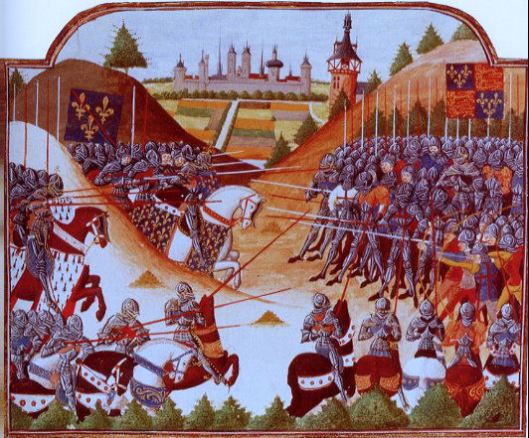
One of the closing battles in the Hundred Years’ War (1337–1453).
Fought on 15 April 1450, the battle of Formigny destroyed the last English field force in Lancastrian NORMANDY and thereby ensured the French reconquest of the duchy.
In June 1449, three months after the English sack of FOUGĖRES, CHARLES VII repudiated the Truce of TOURS and reopened the HUNDRED YEARS WAR by invading Normandy. Since the English had no field army in the duchy, the campaign quickly became a series of sieges; ROUEN capitulated in October and HARFLEUR followed in December. To halt the French advance, the government of HENRY VI dispatched an army of twenty-five hundred men to Normandy under Sir Thomas Kyriell. Landing at Cherbourg on 15 March 1450, Kyriell, acting at the request of local officials, deviated from his orders to proceed immediately to the relief of Bayeux. Instead, he asked Edmund BEAUFORT, duke of Somerset, the English governor of Normandy, for reinforcements to recapture Valognes, which fell on 10 April. Now commanding an army of four thousand, Kyriell marched toward Bayeux, reaching the village of Formigny on 14 April.
The French had two forces in western Normandy. John, count of Clermont, commanded three thousand men at Carentan, while Arthur de Richemont, constable of France, lay twenty miles to the southwest at Coutances with two thousand Bretons. Unwilling to engage the larger English force alone, Clermont allowed Kyriell to proceed unmolested while Richemont marched north to St. Lô , which he reached on 14 April. At Formigny, the English were only ten miles from the safety of Bayeux, but instead of resuming his march, Kyriell held his position, presumably waiting to catch Clermont, whom he knew to be finally on the move. Unaware of Richemont’s march of the previous day, Kyriell probably hoped to engage and defeat Clermont before Richemont arrived.
At mid-afternoon, Clermont encountered the English army drawn up much as HENRY V’s had been at AGINCOURT, with a thin line of men-at-arms fortified at intervals by groups of ARCHERS that projected forward from the English front. Some 75 percent of the English troops were longbowmen. They took positions behind a crop of Spanish riders, backed by a small creek. After a pause that allowed the English to further entrench their position, Clermont’s dismounted men-at-arms assaulted the English line. When their first attack collapsed, the French sent cavalry charges against the English flanks, but were again unsuccessful. Clermont then brought forward two long-range coulverines on wheeled carriages, enfilading the English line. These guns fired into the dense pack of archers, out of range of return longbow fire but with a rate of fire and accuracy of their own rapid enough to tell heavily against limbs and lives. In desperation, the longbowmen charged and overran the coulverines. But terrible casualties had been inflicted and the French had other cannon with which to pound the English position. The French were now in disarray; had Kyriell attacked, he might have driven them from the field.
At this moment, Richemont arrived from the south, his forces ideally positioned to assault the flanks and rear of the English army. The second French army now attacked; 1,200 horse trailed by 800 crossbowmen. These reinforcements forced English survivors into a defensive arc so dense that it inhibited firing by many longbowmen, while the French assaulted from two directions at once. Lacking a reserve, Kyriell had to maintain his front against Clermont while shifting part of his army to the left to meet Richemont’s attack, the sight of which encouraged Clermont’s men to resume their assault. The English line quickly disintegrated under the pressure, with groups of men being surrounded and cut down. Although Sir Matthew Gough, commander of Somerset’s reinforcements, led a small force to safety, most of the English army was killed or captured, with Kyriell among the latter. The English line collapsed under intense crossbow and gun fire; the whole English army was killed, captured, or fled the field (the latter ran all the way to Caen) in utter panic. Having disposed of Kyriell’s army, the French resumed their campaign of sieges, which concluded on 12 August with the fall of Cherbourg, the last English-held fortress in Normandy.
Further Reading: Burne, Alfred H. The Agincourt War. Ware, England: Wordsworth Editions Ltd., 1999; Griffiths, Ralph A. The Reign of King Henry VI.